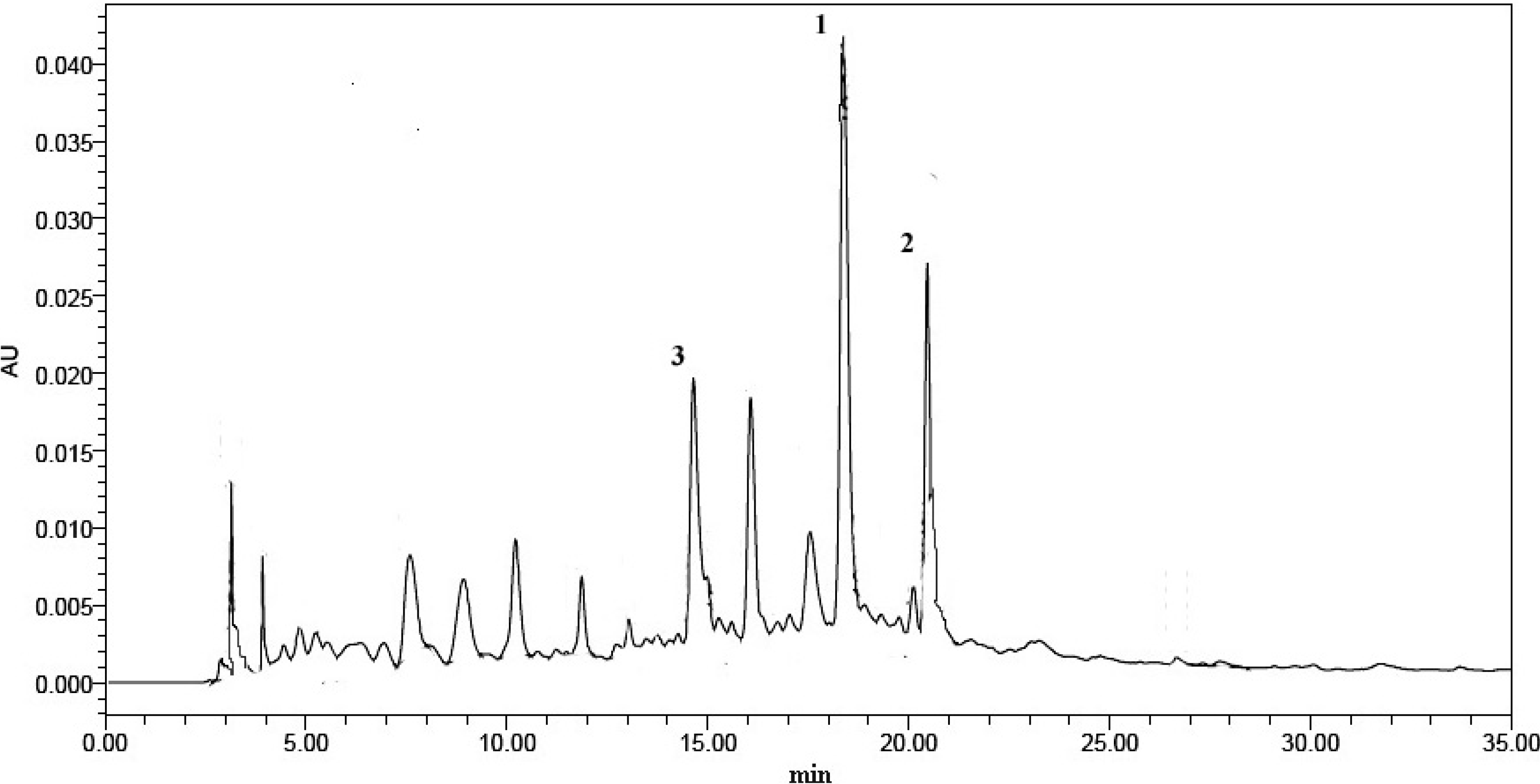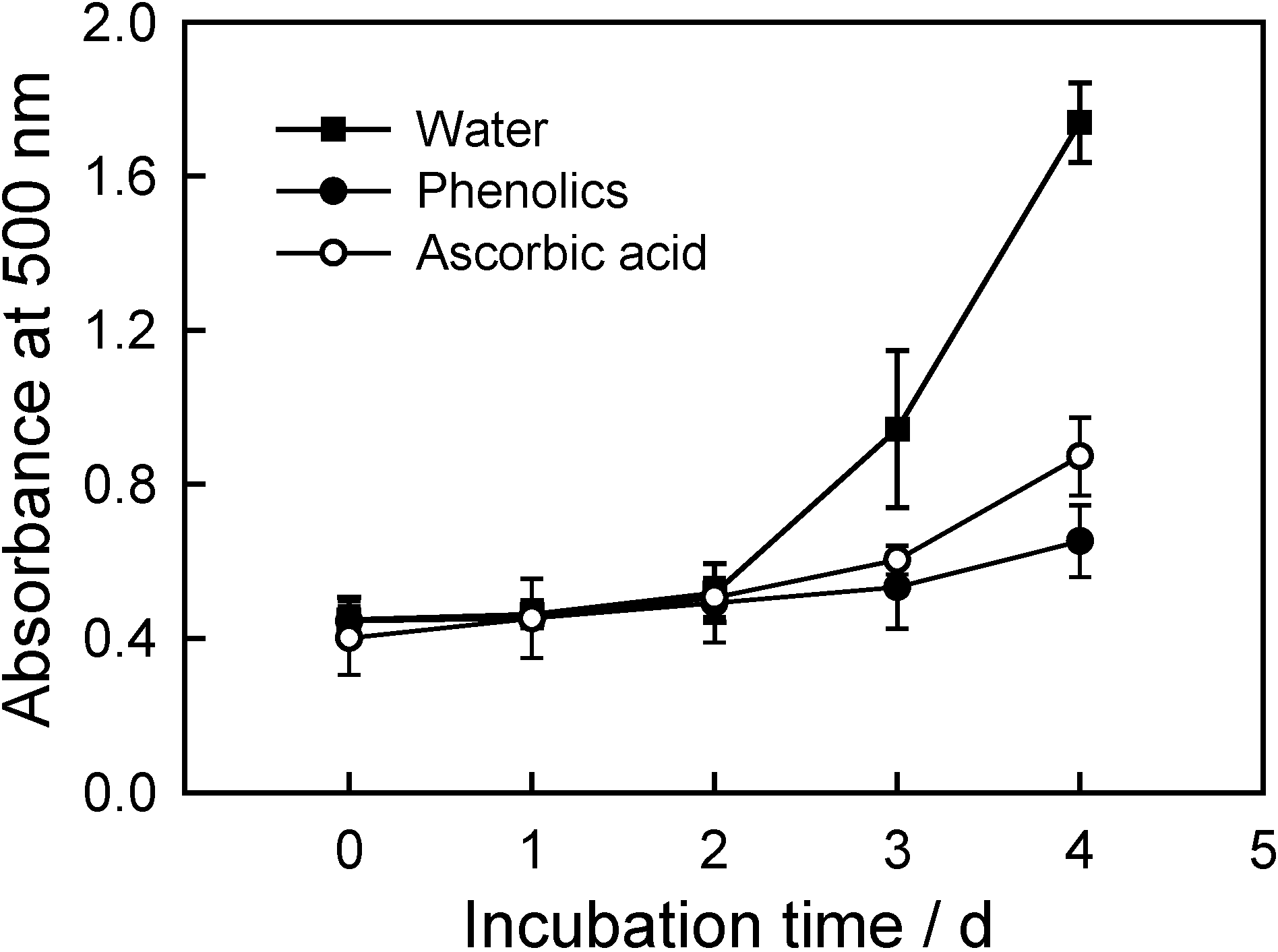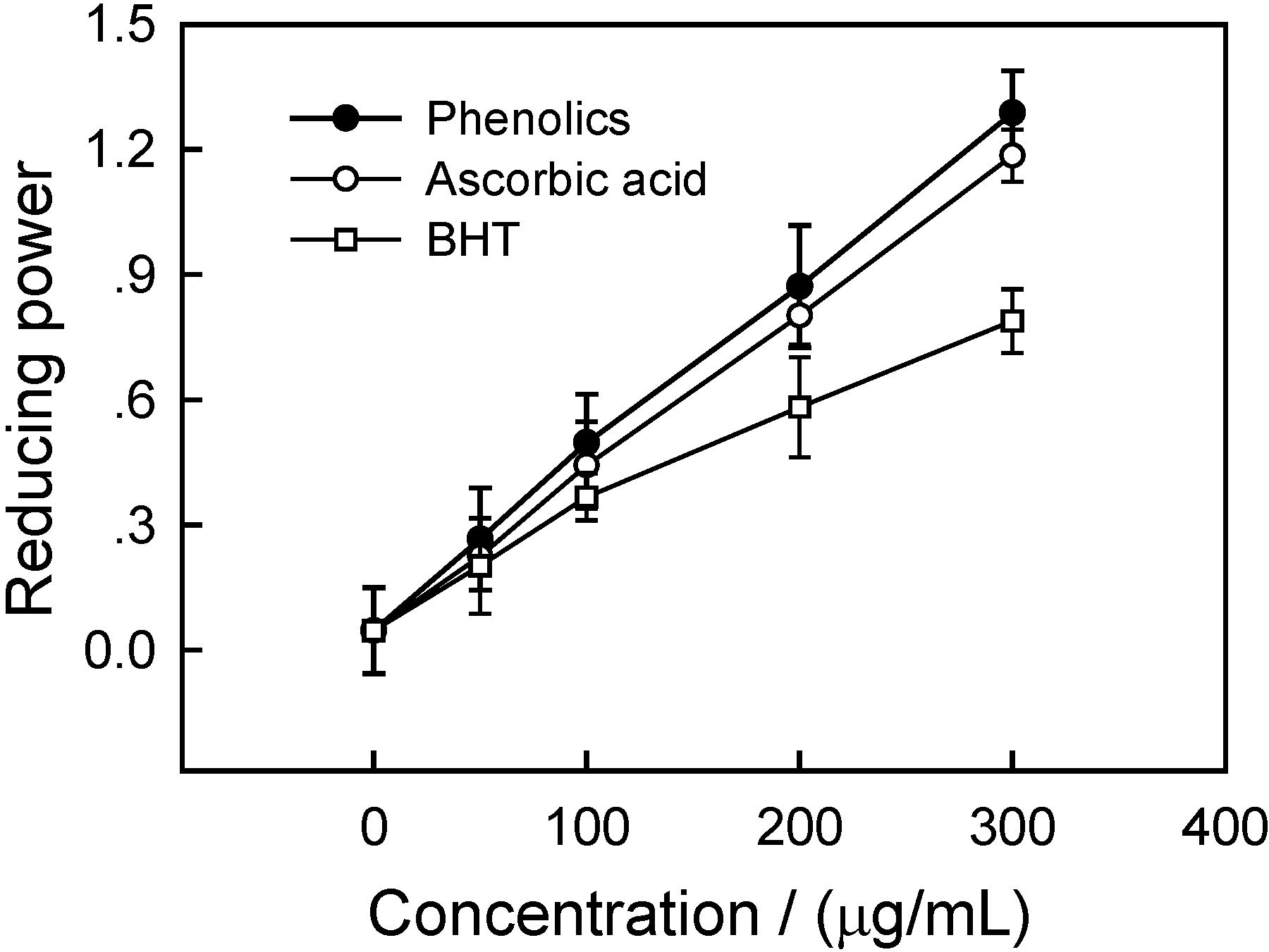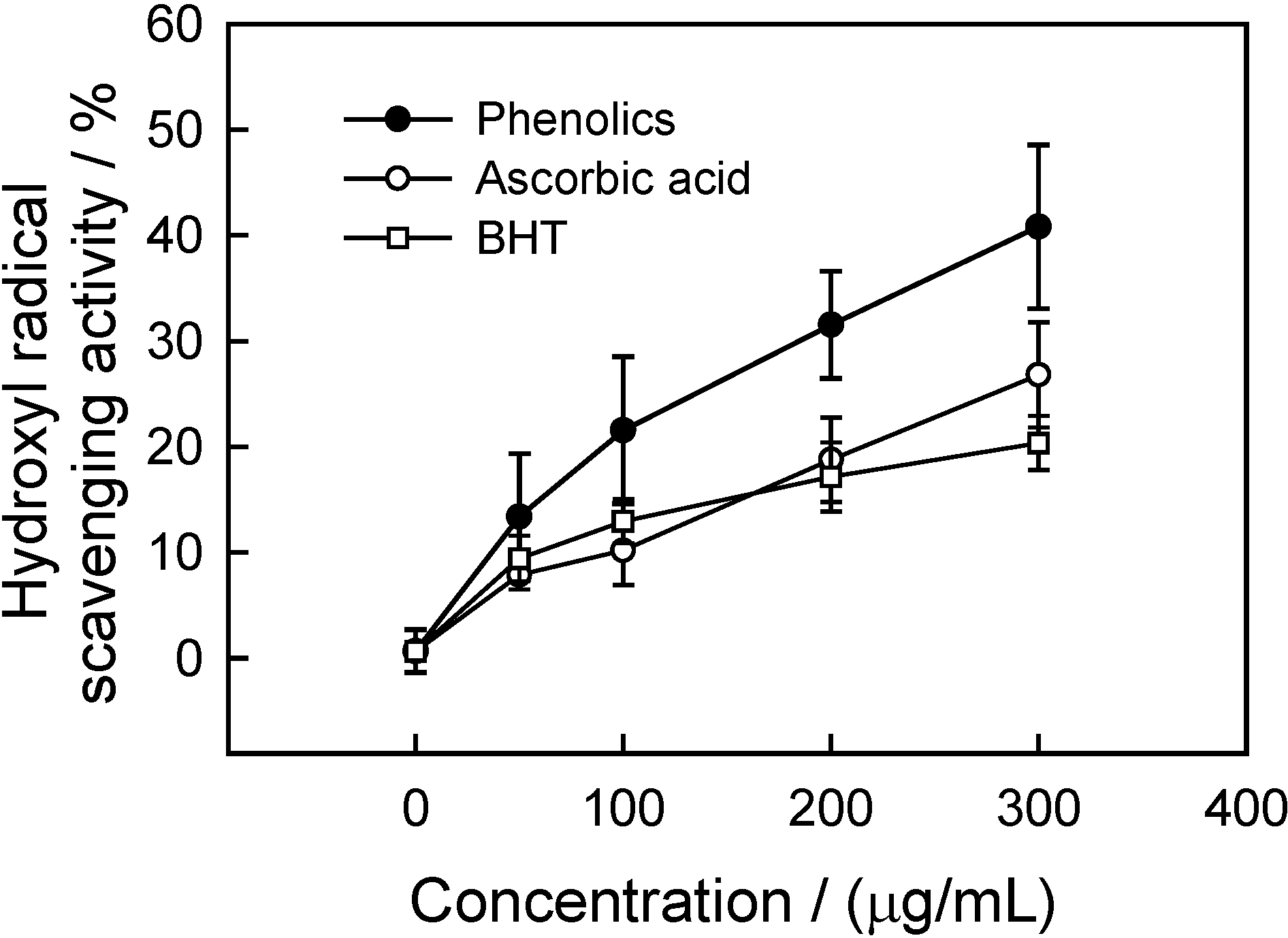Identificationof Major Phenolic Compounds of Chinese Water Chestnut and their Antioxidant Activity
Abstract
:Introduction
Results and Discussion
Extraction and purification of phenolics from CWC


Antioxidant activity in linoleic acid system

Reducing power

DPPH· radical scavenging activity

Superoxide anion scavenging activity

Hydroxyl radical scavenging activity

Conclusions
Experimental Section
Plant materials
Extraction and purification of phenolics
High-Performance Liquid Chromatography (HPLC) analysis
Antioxidant activity in linoleic acid system
Reducing power
Scavenging activity of DPPH radical
Superoxide radical scavenging activity
Hydroxyl radical scavenging activity
Total phenolic content
Statistical analysis
Acknowledgments
References
- Halliwell, B.; Gutteridge, J.M.C.; Cross, C.E. Free radicals, antioxidants and human disease: where are we now? J. Lab. Clin. Med. 1992, 119, 598–620. [Google Scholar]
- Lefer, D.J.; Grander, D.N. Oxidative stress and cardiac disease. Amer. J. Med. 2000, 109, 315–323. [Google Scholar] [CrossRef] [PubMed]
- Viana, M.; Aruoma, O.I.; Herrera, E.; Bonet, B. Oxidative damage in pregnant diabetic rats and their embryo. Free Radical Biol. Med. 2000, 29, 1115–1121. [Google Scholar] [CrossRef]
- Hanninen, O.; Kaartinen, K.; Rauma, A.L.; Nenenen, M.; Torronen, R.; Hakkinen, S.; Adlercreutz, H.; Laakso, J. Antioxidants in vegan diet and rheumatic disorders. Toxicology 2000, 155, 45–53. [Google Scholar] [CrossRef] [PubMed]
- Hu, H.L.; Forsey, R.J.; Blades, T.J.; Barott, M.E.J. Antioxidant may contribute in the fight against aging: an in vitro model. Mech. Ageing Dev. 2000, 121, 217–230. [Google Scholar] [CrossRef] [PubMed]
- Khodr, B.; Khalil, Z. Modulation of inflammation by reactive oxygen species: implications for aging and tissue repair. Free Radical Biol. Med. 2001, 30, 1–8. [Google Scholar] [CrossRef]
- Potter, J.D. Vegetables, fruit, and cancer. Lancet 2005, 366, 527–530. [Google Scholar]
- Robards, K.; Prenzler, P.D.; Tucker, G.; Swatsitang, P.; Glover, W. Phenolic compounds and their role in oxidative processes in fruit. Food Chem. 1999, 66, 401–436. [Google Scholar] [CrossRef]
- Rice-Evans, C.; Miller, N.J.; Paganga, G. Antioxidant properties of phenolic compounds. Trends Plant Sci. 1997, 2, 152–159. [Google Scholar]
- Peng, L.T.; Jiang, Y.M. Effects of chitosan coating on shelf life and quality of fresh-cut Chinese water chestnut. LWT-Food Sci. Technol. 2003, 36, 359–364. [Google Scholar]
- Liu, X.; Zhao, L.C.; Zhou, A.M. Preliminary study on functional component and functional activities of waste slurry derived in processing water chestnut starch. Food Sci. 2006, 27, 251–256. [Google Scholar]
- Zhao, L.C.; Liu, X.; Chen, Y.Q. Preliminary study of chufa functional components in preserving water chestnut cake. Food Sci. 2005, 26, 422–424. [Google Scholar]
- Stoilova, I.; Krastanov, A.; Stoyanova, A.; Denevc, P.; Gargova, S. Antioxidant activity of a ginger extract (Zingiber officinale). Food Chem. 2007, 102, 764–770. [Google Scholar] [CrossRef]
- Soong, Y.Y.; Barlow, P.J. Antioxidant activity and phenolic content of selected fruit seeds. Food Chem. 2004, 88, 411–417. [Google Scholar] [CrossRef]
- Chang, L.W.; Yen, W.J.; Huang, S.C.; Duh, P.D. Antioxidant activity of sesame coat. Food Chem. 2002, 78, 347–354. [Google Scholar]
- Luximon-Ramma, A.; Bahorun, T.; Soobrattee, M.A.; Aruoma, O.I. Antioxidant activities of phenolic, proanthocyanidin, and flavonoid compontents in extracts of Cassia fistula. J. Agric. Food Chem. 2002, 50, 5042–5047. [Google Scholar]
- Pin-Der-Duh, X. Antioxidant activity of burdock (Arctium lappa Linne): its scavenging effect on free-radical and active oxygen. J. Amer. Oil Chem. Soc. 1998, 75, 455–461. [Google Scholar]
- Ratheea, J.S.; Hassarajania, S.A.; Chattopadhyay, S. Antioxidant activity of Nyctanthes arbor-tristis leaf extract. Food Chem. 2007, in press. [Google Scholar]
- Deithton, N.; Brnnan, R.; Finn, C.; Davies, H.V. Antioxidant properties of domesticated and wild Rubus species. J. Agric. Food Chem. 2000, 80, 1307–1313. [Google Scholar] [CrossRef]
- Gil, M.I.; Tomas-Barberan, F.A.; Hess-Pierce, B.; Holcroft, D.M.; Kader, A.A. Antioxidant activity of pomegranate juice and its relationship with phenolic composition and processing. J. Agric. Food Chem. 2000, 48, 4581–4589. [Google Scholar] [CrossRef] [PubMed]
- Burns, J.; Gardner, P.T.; Mcphail, D.B.; O’nell, J.; Crawford, S.; Morecroft, I.; Lister, C.; Matthews, D.; Maclean, M.R.; Lean, M.E.J.; Duthie, G.G.; Crozier, A. Antioxidant activity, vasodilation capacity and phenolic content of red wines. J. Agric. Food Chem. 2000, 48, 220–230. [Google Scholar] [CrossRef] [PubMed]
- Bloknina, O.; Virolainen, E.; Fagerstedt, K.V. Antioxidants, oxidative damage and oxygen deprivation stress: a Review. Ann. Bot. 2003, 91, 179–194. [Google Scholar] [CrossRef] [PubMed]
- Sanchez-Moreno, C. Methods used to evaluate the free radical scavenging activity in foods and biological systems. Food Sci. Technol. Int. 2002, 8, 121–137. [Google Scholar]
- Sun, J.; Chu, Y.F.; Wu, X.; Liu, R.H. Antioxidant and antiproliferative activities of common fruits. J. Agric. Food Chem. 2002, 50, 7449–7454. [Google Scholar] [CrossRef] [PubMed]
- Rollet-Labelle, E.; Grange, M.J.; Elbim, C.; Marquetty, C.; Gougerot-Pocidalo, M.A.; Pasquier, C. Hydroxyl radical as a potential intracellular mediator of polymorphonuclear neutrophil apoptosis. Free Radical Bio. Med. 1998, 24, 563–572. [Google Scholar]
- Moskovitz, J.; Yim, K.A.; Choke, P.B. Free radicals and disease. Arch. Biochem. Biophys. 2002, 397, 354–359. [Google Scholar] [CrossRef] [PubMed]
- Zhang, D.L.; Quantick, P.C.; Grigor, J.M. Changes in phenolic compounds in litchi (Litchi chinensis Sonn.) fruit during posthravest storage. Postharv. Biol. Technol. 2000, 19, 165–172. [Google Scholar]
- Takao, T.; Kitatani, F.; Watanabe, N.; Yagi, A.; Sakata, K. A simple screening method for antioxidants and isolation of several antioxidants produced by marine bacteria from fish and shellfish. Biosci. Biotechnol. Biochem. 1994, 58, 1780–1783. [Google Scholar] [CrossRef]
- Oyaizu, M. Studies on products of browning reaction: antioxidative activity of products of browning reaction prepared from glucosamine. J. Nutr. 1986, 44, 307–315. [Google Scholar]
- Duan, X.W.; Jiang, Y.M.; Su, X.G.; Zhang, Z.Q.; Shi, J. Anthioxidant properties of anthocyanins extracted from litchi (Litchi chinenesis Sonn) fruit pericarp tissue in relation to their role in the pericarp browning. Food Chem. 2007, 101, 1382–1388. [Google Scholar] [CrossRef]
- Siddhurajua, P.; Mohanb, P.S.; Bechera, K. Studies on the antioxidant activity of Indian Laburnum (Cassia fistula L.): a preliminary assessment of crude extracts from stem bark, leaves, flowers and fruit pulp. Food Chem. 2002, 101, 1382–1388. [Google Scholar]
- Lee, J.C.; Kim, H.R.; Kim, J.; Jang, Y.S. Antioxidant property of an ethanol extract of the stem of Opuntia ficus-indica var. Saboten. J. Agric. Food Chem. 2002, 50, 6490–6496. [Google Scholar] [CrossRef]
- Singleton, V.L.; Rossi, J.A. Colorimetry of total phenolics with phosphomolybdic-phosphotungstic acid reagents. Amer. J. Enol. Viticult. 1965, 16, 144–158. [Google Scholar]
- Sample Availability: Available from the authors.
© 2007 by MDPI (http://www.mdpi.org). Reproduction is permitted for noncommercial purposes.
Share and Cite
You, Y.; Duan, X.; Wei, X.; Su, X.; Zhao, M.; Sun, J.; Ruenroengklin, N.; Jiang, Y. Identificationof Major Phenolic Compounds of Chinese Water Chestnut and their Antioxidant Activity. Molecules 2007, 12, 842-852. https://doi.org/10.3390/12040842
You Y, Duan X, Wei X, Su X, Zhao M, Sun J, Ruenroengklin N, Jiang Y. Identificationof Major Phenolic Compounds of Chinese Water Chestnut and their Antioxidant Activity. Molecules. 2007; 12(4):842-852. https://doi.org/10.3390/12040842
Chicago/Turabian StyleYou, Yanli, Xuewu Duan, Xiaoyi Wei, Xinguo Su, Mouming Zhao, Jian Sun, Neungnapa Ruenroengklin, and Yueming Jiang. 2007. "Identificationof Major Phenolic Compounds of Chinese Water Chestnut and their Antioxidant Activity" Molecules 12, no. 4: 842-852. https://doi.org/10.3390/12040842
APA StyleYou, Y., Duan, X., Wei, X., Su, X., Zhao, M., Sun, J., Ruenroengklin, N., & Jiang, Y. (2007). Identificationof Major Phenolic Compounds of Chinese Water Chestnut and their Antioxidant Activity. Molecules, 12(4), 842-852. https://doi.org/10.3390/12040842






